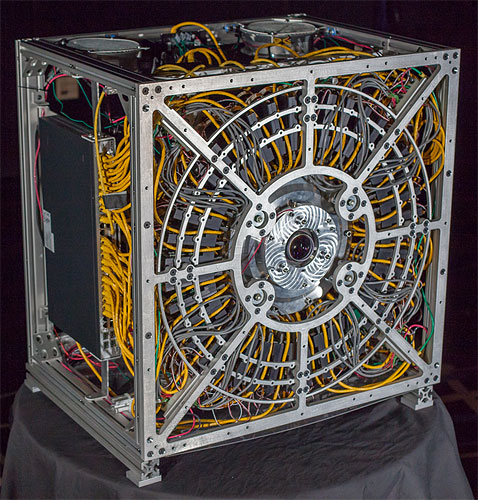Prepare for pixel envy: Duke University creates portable, gigapixel camera
posted Monday, June 25, 2012 at 2:05 PM EDT
 How many pixels can you fit into a liter? A bit of a nonsensical question, perhaps, but for a prototype camera built by researchers at Duke University in Durham, North Carolina, the answer is around 270 megapixels.
How many pixels can you fit into a liter? A bit of a nonsensical question, perhaps, but for a prototype camera built by researchers at Duke University in Durham, North Carolina, the answer is around 270 megapixels.
Duke's researchers, working in cooperation with the University of Arizona and the University of California San Diego, have been given a tough goal by the Defense Advanced Research Projects Agency, part of the US Department of Defense. DARPA is seeking to provide the US military with new imaging systems that would provide orders of magnitude greater resolutions than are currently available, while maintaining a relatively compact and lightweight design that would be suitable for use both on the ground, and in the air. Duke's first prototypes can already provide multiple gigapixel resolution from an optical system of somewhere around 8 liters in volume, excluding the supporting electronics.
|
A gigapixel capture with the AWARE-2 prototype. Click to see a zoomable version of the same image on the AWARE wide field camera website. Photo provided by Duke University. |
DARPA's AWARE project--the acronym is short for Advanced Wide FOV Architectures for Image Reconstruction and Exploitation--was launched last year, and to date two prototype camera variants have been made, with the first gigapixel demonstration shown last September. Both prototypes place a large number of cameras behind a single large monocentric lens, dubbed the Gigagon. Focus and exposure of each individual camera are set separately, and each camera contributes only a relatively small portion of the overall image, which is automatically stitched on capture. Impressively, it's not only possible to create extremely high-res images from a single simultaneous exposure of the many microcameras, but also to use pixel binning techniques to reduce resolution enough to provide a display-scaled live view image, allowing near-realtime preview of the scene before the high-res capture.
|
Duke University's AWARE-2 camera prototype. Image provided by Duke University. |
In the current prototypes, the microcameras each have 14 megapixel resolution. One prototype variant includes a total of 98 microcameras, for a total of 1.4 gigapixels of source data. After overlaps are accounted for, this can provide a 0.96 gigapixel final image with a 120 by 42 degree field of view, transferred via ethernet in around 13.5 seconds. With 16x binning, a live view image can be transferred every 0.4-0.6 seconds. The higher-resolution prototype is similar, but adds more microcameras vertically, for a 120 by 70 degree field of view. With 150 microcameras in this design, there's a total of around 2.1 gigapixels of raw data, and a 1.47 gigapixel final image. Transfer times are 21 seconds for the full image, and again around 0.4 to 0.6 seconds for the binned live view image.
|
A gigapixel demonstration of the AWARE-2 camera. Even the finest writing on the license plate of the car at left can easily be discerned. Photos provided by Duke University. |
Both designs fit inside a 0.75 x 0.75 x 0.5 meter package, for an enclosure volume of 300 liters. Most of this is the supporting electronics, cabling, and the structure of the enclosure itself; even in the current prototypes the optical system's volume is only around 8 liters. The lower-resolution version weighs in at some 93 kilograms, and draws 426 watts in operation. Although no weight is stated for the higher-res version, it takes around 588 watts to operate. These are just prototypes, though. According to Duke's introductory document, the designs should scale to around a 40 gigapixel system.
There's also more work to be done to create a high-quality image, as noted by Duke, which is currently working on a ten gigapixel version slated to be tested later this year. There are a variety of image defects in the first prototypes caused by pointing and registration errors of the microcameras, as well as issues with stray light and deficiencies in the initial microcamera optics. Still, even with these defects in the prototypes, the results are still quite impressive--as is the huge amount of work involved in assembling one of these mighty beasts, as shown in the video below.



